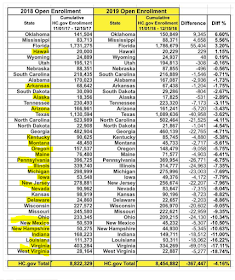In yesterday's post, I missed the most startling point in the ACA enrollment data I'd been staring at.
It's this: In 2019, virtually all of the enrollment decline in the ACA marketplace was concentrated in states on the HealthCare.gov platform that have expanded Medicaid. That's excluding Virginia and Maine, which are expanding Medicaid in 2019.*
Charles Gaba projects virtually flat enrollment in the states that run their own exchanges, in many of which enrollment for 2019 is still open. In the 16 remaining non-expansion states using HealthCare.gov, enrollment in 2019 is down less than 1% from enrollment in 2018 (excluding late adjustments, which should roughly cancel out similar adjustments made last year). Enrollment in the 21 HealthCare.gov states that have expanded Medicaid (excluding VA and ME) is down 7% in 2019. It was also down 7% in 2018, compared to 4% the in non-expansion states.
As I noted yesterday, outsized enrollment losses in 2018 were concentrated at lower income levels, where enrollment assistance is probably most vital, and where the value of Cost Sharing Reduction (CSR) mostly outstrips the value of bronze and gold discounts generated by silver loading** (an income breakout is not yet available for 2019). In HealthCare.gov expansion states, enrollment in the 100-150% FPL income band, where CSR is strongest, cratered in 2018, dropping 14%. At 150-200% FPL, enrollment in these states dropped 11%.
At higher income levels, as was the case generally in 2018, silver loading discounts in these states seem to have partially offset the forces driving enrollment down at lower income levels. At 300-400% FPL, enrollment in these states was up 8% in 2018 (it was up 12% in non-expansion states).
It's this: In 2019, virtually all of the enrollment decline in the ACA marketplace was concentrated in states on the HealthCare.gov platform that have expanded Medicaid. That's excluding Virginia and Maine, which are expanding Medicaid in 2019.*
Charles Gaba projects virtually flat enrollment in the states that run their own exchanges, in many of which enrollment for 2019 is still open. In the 16 remaining non-expansion states using HealthCare.gov, enrollment in 2019 is down less than 1% from enrollment in 2018 (excluding late adjustments, which should roughly cancel out similar adjustments made last year). Enrollment in the 21 HealthCare.gov states that have expanded Medicaid (excluding VA and ME) is down 7% in 2019. It was also down 7% in 2018, compared to 4% the in non-expansion states.
As I noted yesterday, outsized enrollment losses in 2018 were concentrated at lower income levels, where enrollment assistance is probably most vital, and where the value of Cost Sharing Reduction (CSR) mostly outstrips the value of bronze and gold discounts generated by silver loading** (an income breakout is not yet available for 2019). In HealthCare.gov expansion states, enrollment in the 100-150% FPL income band, where CSR is strongest, cratered in 2018, dropping 14%. At 150-200% FPL, enrollment in these states dropped 11%.
At higher income levels, as was the case generally in 2018, silver loading discounts in these states seem to have partially offset the forces driving enrollment down at lower income levels. At 300-400% FPL, enrollment in these states was up 8% in 2018 (it was up 12% in non-expansion states).


